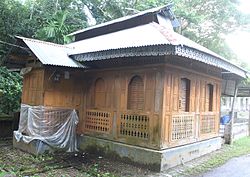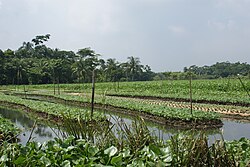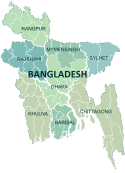Pirojpur District
This article needs additional citations for verification. (October 2009) |
Pirojpur
পিরোজপুর | |
|---|---|
| Pirojpur District | |
Top: Momin Mosque Bottom: Floating fields in Baithakatha village. | |
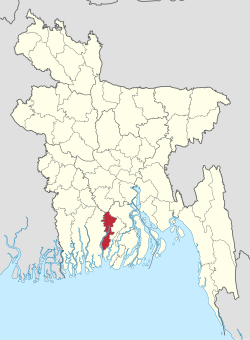 Location of Pirojpur in Bangladesh | |
 Expandable map of Pirojpur District | |
| Coordinates: 22°35′N 89°58′E / 22.58°N 89.97°E | |
| Country | |
| Division | Barisal |
| Headquarters | Pirojpur |
| Government | |
| • Deputy Commissioner | Abu Ali Md. Shazzad Hossain |
| Area | |
| • Total | 1,277.80 km2 (493.36 sq mi) |
| Population | |
| • Total | 1,198,195 |
| • Density | 940/km2 (2,400/sq mi) |
| Demonym(s) | Pirojpuri, Firozpuri |
| Time zone | UTC+06:00 (BST) |
| Postal code | 8500 |
| Area code | 0461 |
| ISO 3166 code | BD-50 |
| HDI (2018) | 0.672[2] medium · 2nd of 21 |
Pirojpur (Bengali: পিরোজপুর) is a district (zilla) in south-western Bangladesh. It is a part of Barisal Division.[3]
Etymology
[edit]According to some, the second son of Subedar Shah Shuja, Firoz Shah, died in this area, and the area became known subsequently as 'Firozpur'. In time, the pronunciation 'Firozpur' slowly muted to 'Pirozpur' and later 'Pirojpur'.[4]
Geography
[edit]Pirojpur is bounded by Barisal and Gopalganj districts to the north, Barguna district to the south, Jhalokati and Barguna districts to the east, Bagerhat district and Sundarban to the west. Baleswari River separates Pirojpur from Bagerhat in the west
Most of the land is low-lying and the soil is fertile. There are small forests. Nesarabad is known for its business centre and also for the Sundori tree (a kind of mangrove) that grows there. The northern part of the district especially is known for its wetland areas.
Rivers
[edit]Gabkhan, Baleshwar, Damodar, Kocha, Pona, Kochakhali, Kaliganga, Sandha, Doratana etc. are big and known rivers.
The Baleshwar, the river that is situated to the east of Sunder Bans splits into two parts, but this is getting smaller and smaller day by day. One is known as Doratana which flows through Bagerhat and the other and mightier one is known as Kacha which flows through Bhandaria. Then it has an offshoot Baleshwar which later meets with Doratana and falls into Kaliganga near Mativanga, Najirpur. And Kocha splits into two river Kaliganga and Sandha. Kaliganga flows to the north meets with Baleshwar and flow to further north. and Sandha flows to the east. Later Sandha coalesce with Arial Khan and falls into the Meghna.
Demographics
[edit]| Year | Pop. | ±% p.a. |
|---|---|---|
| 1974 | 823,787 | — |
| 1981 | 947,420 | +2.02% |
| 1991 | 1,063,185 | +1.16% |
| 2001 | 1,111,068 | +0.44% |
| 2011 | 1,113,257 | +0.02% |
| 2022 | 1,198,195 | +0.67% |
| Sources:[1][5] | ||
According to the 2022 Census of Bangladesh, Pirojpur District had 298,490 households and a population of 1,198,195 with an average 3.97 people per household. Among the population, 218,660 (18.25%) inhabitants were under 10 years of age. The population density was 938 people per km2. Pirojpur District had a literacy rate (age 7 and over) of 85.53%, compared to the national average of 74.80%, and a sex ratio of 1056 females per 1000 males. Approximately, 19.98% of the population lived in urban areas. The ethnic population was 120.[1]
Religion
[edit]| Religion | 1941[6]: 100–101 [a] | 1981[5] | 1991[5] | 2001[5] | 2011[5] | 2022[1] | ||||||
|---|---|---|---|---|---|---|---|---|---|---|---|---|
| Pop. | % | Pop. | % | Pop. | % | Pop. | % | Pop. | % | Pop. | % | |
| Islam |
388,000 | 60.23% | 709,558 | 74.89% | 840,081 | 79.02% | 903,952 | 81.36% | 925,895 | 83.17% | 1,017,024 | 84.88% |
| Hinduism |
255,748 | 39.70% | 237,383 | 25.06% | 222,330 | 20.91% | 206,468 | 18.58% | 186,865 | 16.79% | 180,982 | 15.10% |
| Others [b] | 477 | 0.07% | 479 | 0.05% | 774 | 0.07% | 648 | 0.06% | 497 | 0.04% | 189 | 0.02% |
| Total Population | 644,225 | 100% | 947,420 | 100% | 1,063,185 | 100% | 1,111,068 | 100% | 1,113,257 | 100% | 1,198,195 | 100% |
Islam is the predominant religion in the district. Since Partition the Hindus have been continuously leaving the district and migrating to India. The percentage share of Hindus is the largest in Nazirpur Upazila and the lowest in Indurkani Upazila.[5]
There are 3,087 mosques and 1,051 temples.[7]
Administration
[edit]The subdivision (then a mohokooma, now a zilla) of Pirojpur was created on 28 October 1859 Pirojpur district was formed on 1 March 1984 and the municipality was formed in 1885. The area of Pirojpur is 1277.80 km2. It is under Barisal Division. There are three municipalities in Pirojpur named Pirojpur, Bhandaria, Mathbaria. There are seven upazilas (sub districts) in Pirojpur district: Pirojpur Sadar, Bhandaria, Mathbaria, Indurkani, Nazirpur, Nesarabad and Kawkhali. Of these, Mathbaria is the largest (353.25 km2; it occupies 27.01% of the total area of the district). Kawkhali is the smallest (79.65 km2). Pirojpur District also contains 52 unions, 390 mauzas and 648 villages.[7]
- Chairman of Zilla Porishod : Mahiuddin Maharaj[8]
- Deputy Commissioner (DC) : Abu Ali Mohammad Sajjad Hossain[9]
Borders
[edit]Pirojpur District is bordered by Barisal and Gopalganj districts to the north, Barguna district to the south, Jhalokati and Barguna districts to the east, Bagerhat district and The Sundarbans, the world's largest mangrove forest to the west.
Sub-districts (Upazillas)
[edit]There are seven Sub-districts in Pirojpur and their population are given below:[10]
| Upazillas |
Population |
|---|---|
| Bhandaria | 164,618 |
| Kawkhali | 70,515 |
| Mathbaria | 262,841 |
| Nazirpur | 180,408 |
| Nesarabad | 212,232 |
| Pirojpur Sadar | 163,470 |
| Indurkani | 77,674 |
Transportation
[edit]Buses
[edit]There are two bus terminals in Pirojpur, Pirojpur Bus terminal and Pirojpur Old Bus Terminal. Many Bus company connect Pirojpur to other districts like Dhaka and many more.
Riverine
[edit]Launches, steamers and boats are used for travelling on the rivers. The local port is called Hoolarhaat Launch Station (ghaat)serving as the primary port for Pirojpur. It is situated some 5 km east to the Pirojpur town and the river port stands on Kaliganga. Beside it is the steamer wharf. Launches destined to Dhaka and other parts of the country regularly start from here.
Tourist attractions
[edit]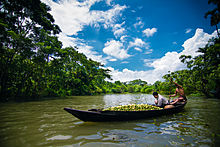
- Tasmima Villa, Bhandaria
- Bhandaria Thana Echo Park, Bhandaria
- Aman Ullah Collage, (Baridara Complex), Khatalia Road, Bhandaria.
- Minister Bari Mosque, Bhandaria.
- Kuriana Floating Market
- Kuriana Guava Garden
- Momin Mosque
- Chanmari Shooting Spot
- Pirojpur River View Eco Park (locally known as DC Park)
- Rayerkathi Raaj Bari
- Horinpala River View Eco Park, Telikhali Union, Mathbaria
- Shapleza Kuthibari, Mathbaria
- Baleshwari,River
- Grave of Delwar Hossain Sayeedi
- Charkhali Ferry Terminal
Economy
[edit]Agriculture is the main source of income for rural people here. There are also other sources of income which are mainly city based. They are given below:
- Agriculture 50.82%
- Commerce 18.71%
- Service 7.69%
- Non-agricultural labour 5.75%
- Transport and communication 2.16%,
- Religious service 1.61%
- Construction 1.36%
- Rent and remittance 0.95%
- Industry 0.78%
- Others 10.17%
Agricultural products
[edit]Paddy, Elephant Apple, Jute, Sugar Cane, Wheat, Guava, Banana, Coconut, Hog-plum, Betel Leaf, Betel Nuts, are the chief Agricultural Products produced here.[11]
Media
[edit]- Manobkantha (national)
- Sangbad (national)
- Prothom Alo (national)
- Kaler Kantho (national)
- Samakal (national)
- Dainik Janakantha (national)
- Jugantor (national)
- Pirojpurer Kotha (local)
Notable people
[edit]- Ahsan Habib
- Anwar Hossain Manju
- Delwar Hossain Sayeedi, Islamic scholar and politician
- Hatem Ali Jamadar, member of the Bengal Legislative Assembly
- Jewel Aich
- Jannatul Ferdous Oishee, model, was born at Matibhanga village and completed her HSC in Nazirpur.[12]
- Khalid Hassan Milu[citation needed]
- Tofazzal Hossain Manik Miah
- SM Rezaul Karim
- Nesaruddin Ahmad, first Pir of Sarsina
- Abu Zafar Mohammad Saleh, Islamic scholar and Independence Award recipient
See also
[edit]Notes
[edit]- ^ Pirojpur subdivision of Bakerganj district excluding thanas of Banaripara, Bamna, and Pathargata
- ^ Including Jainism, Christianity, Buddhism, Zoroastrianism, Judaism, Ad-Dharmis, or not stated
References
[edit]- ^ a b c d e Population and Housing Census 2022 National Report (PDF). Vol. 1. Bangladesh Bureau of Statistics. November 2023.
- ^ "Sub-national HDI - Area Database - Global Data Lab". hdi.globaldatalab.org. Retrieved 18 March 2020.
- ^ Nupu, Ranjan Baksi (2012). "Pirojpur District". In Islam, Sirajul; Jamal, Ahmed A. (eds.). Banglapedia: National Encyclopedia of Bangladesh (Second ed.). Asiatic Society of Bangladesh.
- ^ "The Daily Ittefaq" (in Bengali).
- ^ a b c d e f "Bangladesh Population & Housing Census-2011, Zila Report: Pirojpur" (PDF). Bangladesh Bureau of Statistics.
- ^ "Census of India, 1941 Volume VI Bengal Province" (PDF). Retrieved 13 August 2022.
- ^ a b "Pirojpur District at a glimpse". 28 August 2019.
- ^ "Zilla Porishod Chairman Information". Pirojpur Zilla. 10 August 2019.
- ^ "Deputy Commissioner Profile". Pirojpur Zilla. 10 August 2019.
- ^ 2011 Census of Population
- ^ "Natural Assets in Pirojpur". 28 August 2019.
- ^ "IELTS can wait, right now I want to act more: Oishee". The Business Standard. 15 January 2022.

